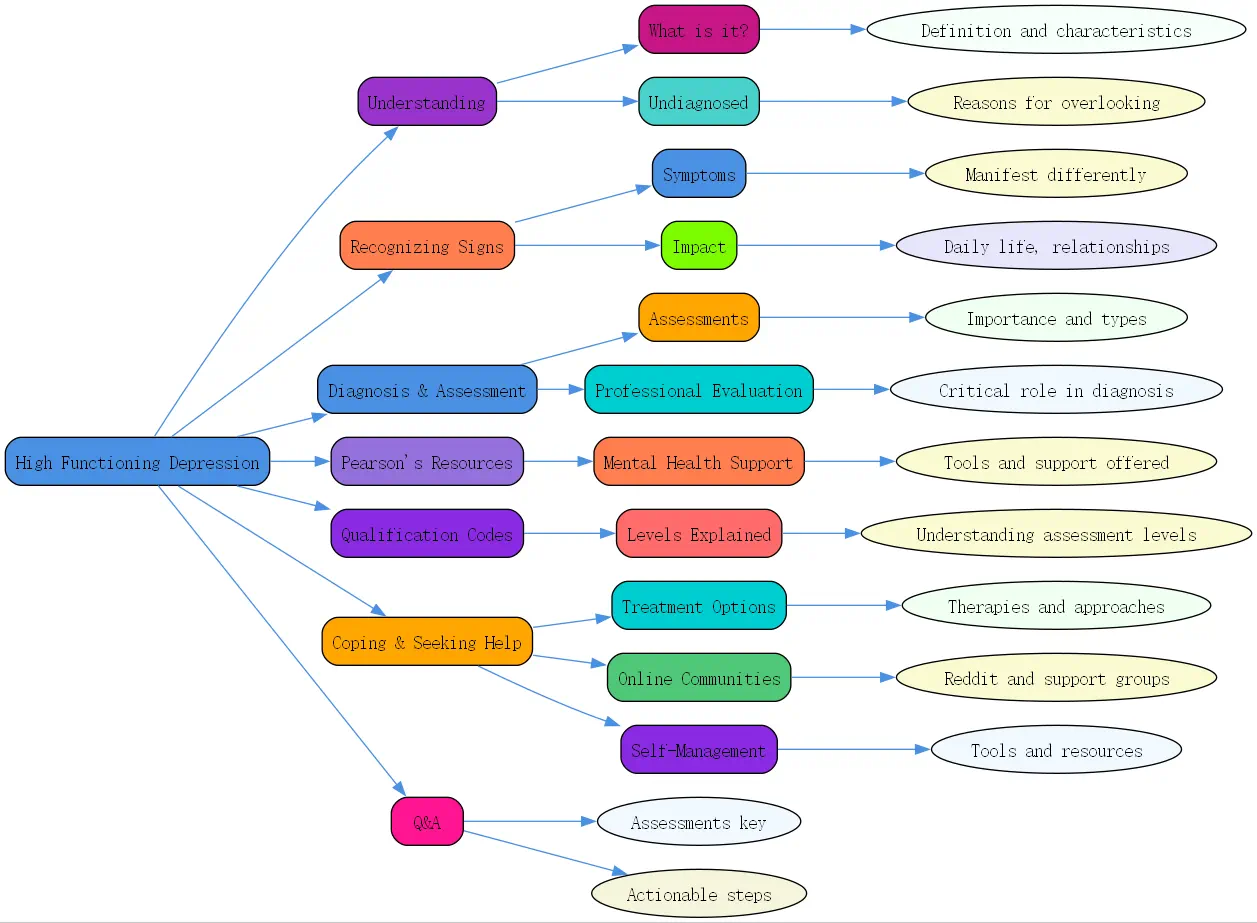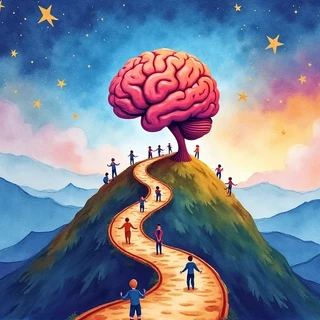High functioning depression is a term buzzing around platforms like Reddit, where people open up about their struggles. Unlike severe depression, those with high functioning depression often keep up with jobs, social lives, and daily tasks. Yet, inside, they wrestle with ongoing sadness and exhaustion. This article, crafted with insights from BrainTalking, dives into what high functioning depression is, how to spot it, and ways to cope effectively.
Understanding High Functioning Depression

What is High Functioning Depression?
High functioning depression, often called persistent depressive disorder (PDD) or dysthymia, is a chronic, milder form of depression. It lingers for at least two years, bringing low mood, tiredness, and poor self-esteem. People still manage their responsibilities, which makes it tricky to spot. BrainTalking highlights that this ability to “”function”” doesn’t erase the real emotional weight it carries.
Differentiating it from other forms of depression
Major depression hits hard, often halting life entirely with intense episodes. High functioning depression, though, is subtler—less crippling but persistent. You might power through work or smile at friends, yet feel empty inside. This difference shapes how it’s treated and understood, often leaving sufferers hesitant to seek help, thinking it’s “”not bad enough.””
Why it often goes undiagnosed
The knack for masking symptoms keeps high functioning depression under the radar. You could ace a presentation while battling despair, fooling even yourself into thinking it’s normal. Its long-term nature blends into life’s fabric, delaying diagnosis. Many avoid stigma or doubt their struggles warrant attention, making professional insight crucial.
Recognizing the Signs of Depression: High Functioning Presentation
Common symptoms and how they manifest differently
High functioning depression brings quieter symptoms than major depression. Expect persistent sadness, low energy, trouble focusing, hopelessness, irritability, and sleep or appetite shifts. Unlike major depression’s knockout punch, these creep in subtly. You might drag through a workday feeling off but still get it done, hiding the storm within.
Internal struggles versus outward appearance
Inside, it’s a whirlwind of guilt and worthlessness. Outside, you’re the picture of “”fine.”” This gap isolates you—nobody sees the pain, and explaining it feels impossible. Loved ones might miss the cues since you’re still showing up. It’s a silent battle that demands attention to bridge the disconnect.
Impact on daily life and relationships
Even with routine intact, high functioning depression seeps into life. Relationships strain as you pull back emotionally or snap unexpectedly. Work suffers with dips in focus or ambition. Over time, it chips away at confidence, leaving you questioning your future. It’s a slow burn that reshapes how you connect and thrive.
Is it High Functioning Depression? Diagnosis and Assessment
Mental Health Assessments for Depression
Diagnosing high functioning depression starts with expert evaluation. Standardized assessments screen symptoms and gauge severity, available digitally or on paper. These tools, vital for telepractice or in-person sessions, uncover what self-reflection might miss. They’re the first step to clarity and tailored support.
Tools used to screen for depression, including digital and paper-based options
Professionals rely on tools like the Beck Depression Inventory (BDI) for self-reported symptom severity, the Patient Health Questionnaire-9 (PHQ-9) for quick depression checks, and the Hamilton Depression Rating Scale (HDRS) for clinician insights. Whether online via Q Global or traditional paper, these assessments paint a full picture of your mental health.
Importance of professional evaluation
Self-tests spark awareness, but pros—like psychologists or therapists—bring precision. They decode results, weigh your unique story, and rule out look-alikes like anxiety. A solid diagnosis from a qualified expert ensures you’re on the right path, not guessing in the dark. It’s a game-changer for effective care.
Pearson’s Mental Health Support Resources
Mental health assessment brochure details
Pearson’s mental health assessment brochure, crafted by top psychology experts, guides professionals through tools for depression, anxiety, and self-esteem. It’s a go-to for spotting issues in kids, teens, and adults. This resource simplifies choosing the right assessment, boosting confidence in supporting mental health needs.
Support for schools: Mental health toolkit
Pearson’s mental health toolkit for schools, built with psychologists and SENCOs, offers practical tips for student well-being. It advises on classroom support and when to call in experts. In 2025, fostering positive mental health in education is more vital than ever, and this toolkit leads the way.
Well-being Zone resources for all ages
The Well-being Zone by Pearson serves up resources for everyone—coping tips for anxiety, fun well-being activities, and mindfulness practices. Perfect for teachers, health pros, and youth, it includes guides like “”Mindfulness for Unsettling Times”” by Ashley Lodge. Visit Pearson UK for a mental health boost.
Qualification Codes Explained (CL1, CL2, CL2R, CL3)

Understanding qualification levels for different assessments
Pearson assigns codes—CL1, CL2, CL2R, CL3—to ensure assessments match user expertise. CL3 suits teachers with basic training. CL2R needs advanced SEN qualifications. CL2 fits certified pros like psychologists. CL1 demands top-tier skills, reserved for HCPC-registered or BPS-chartered psychologists.

Matching your qualifications to appropriate tests
Check your credentials against these codes to pick the right tools. A teacher might use CL3 assessments, while a psychologist taps CL2 or CL1. It’s about safety and accuracy—ensuring you’re equipped to handle the results responsibly.
Where to find qualification information on the Pearson UK website
Head to Pearson UK’s site for a breakdown of qualification codes and eligible assessments. It’s a clear roadmap to match your training with the tools you need. Got questions? Their team’s ready to help you navigate.
Coping and Seeking Help for High Functioning Depression
Available Treatment Options and Therapies
Exploring therapy options tailored to high functioning depression
Therapy shines for high functioning depression. Cognitive-behavioral therapy (CBT) rewires negative thoughts, while interpersonal therapy (IPT) mends relationship rifts. Mindfulness-based cognitive therapy (MBCT) keeps you grounded. Whether in-person or via teletherapy, these options fit your life, offering real relief.
Medication considerations and management
Antidepressants like SSRIs can lift the fog, but they’re not one-size-fits-all. A doctor tailors them to you, tweaking doses and watching for side effects. It’s a partnership—open talks with your provider ensure it works without throwing you off balance.
Lifestyle changes and coping mechanisms
Small shifts make a big difference. Exercise boosts mood, sleep resets your mind, and healthy eating fuels resilience. Hobbies spark joy, mindfulness calms chaos, and realistic goals rebuild purpose. These aren’t cures, but they’re powerful allies in managing daily struggles.
The Role of Online Communities: High Functioning Depression Reddit and Support Groups
Benefits and risks of online support communities
High functioning depression Reddit threads, like r/depression, offer 24/7 solidarity. Anonymity frees you to share, and connection cuts isolation. But beware—misinformation lurks, and some vibes can drag you down. Balance it with real-world care.
Finding reputable and helpful online resources
Stick to trusted spots. Moderated forums or sites like NAMI and ADAA deliver solid info. Avoid random advice pits—look for expert-backed content to guide your journey safely and smartly.
Utilizing online platforms for information and connection
Reddit’s a start, not a fix. Use it to learn about depression high functioning struggles and swap stories. Pair it with pro help for a full support system that informs and uplifts without replacing expert input.

Resources and Tools for Self-Management
Mindfulness techniques and practices
Mindfulness keeps you present. Try meditation, deep breathing, or yoga—apps like Headspace make it easy. Even five minutes daily can quiet the noise, helping you handle high functioning depression with calm and focus.
Strategies for managing stress and anxiety
Stress feeds depression, so fight back. Journaling unloads thoughts, relaxation techniques soothe nerves, and boundaries protect your peace. Time management keeps chaos at bay—simple steps, big impact.
Building a support network
You don’t have to go it alone. Lean on friends, family, or a support group. BrainTalking suggests local or online communities for shared understanding. A strong network lifts you up when the weight feels too much.
Q&A Section
Q: Why are mental health assessments key for high functioning depression?
A: Mental health assessments pinpoint high functioning depression with precision. They measure symptom severity, distinguish it from other conditions, and set a baseline for progress. Pros use them to craft personalized plans, ensuring you get the right help—fast and accurately.
High functioning depression hides in plain sight, but it’s manageable. Spot the signs, seek expert diagnosis, and tap into therapies, communities, and self-care. You’re not alone—resources abound. For more, check BrainTalking’s site or talk to a pro. Take that first step today.
- Watch for subtle signs like ongoing sadness or fatigue.
- Get a pro assessment for a clear diagnosis.
- Try CBT, meds, or lifestyle tweaks to cope.
- Join high functioning depression Reddit for support.
- Practice mindfulness and build a trusted crew.




